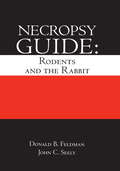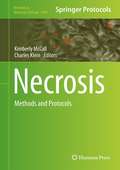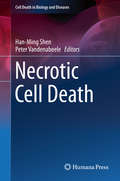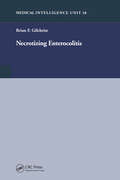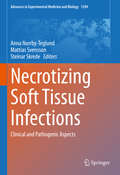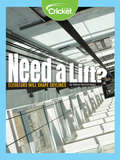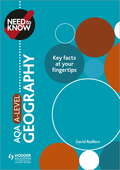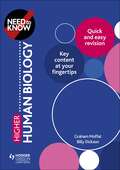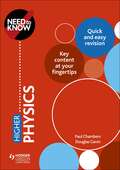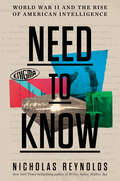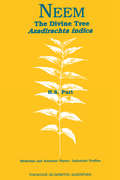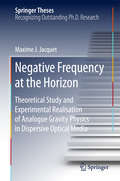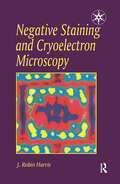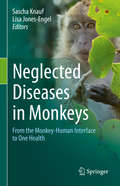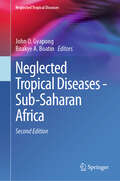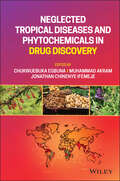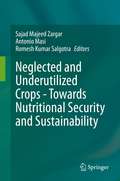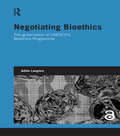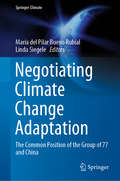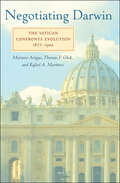- Table View
- List View
Necropsy Guide: Rodents and the Rabbit
by Donald B. Feldman John Curtis SeelyThis laboratory guidebook provides step-by-step procedures that will aid in the dissection and collection of major organs and tissues of the most common species of small animals used in biomedical research. Through extensive use of photographs and illustrations, it guides dissectors through a complete necropsy of each species for the purpose of collecting organs and tissues routinely examined by pathologists. The techniques described enable technicians to perform necropsies on almost any mammal in a precise and logical sequence, and collect tissue properly to avoid diagnostic errors. Morphological differences among the various species are discussed.
Necrosis: Methods and Protocols (Methods in Molecular Biology #1004)
by Kimberly Mccall Charles KleinCell death is an essential process in development, and a major contributor to a wide range of human diseases. Three major classifications of cell death, apoptosis, autophagic cell death and necrosis, have been described for years, and the existence of many more forms of cell death is now accepted. In, Necrosis: Methods and Protocols experts in the field provide a wide range of methods and techniques for the study of necrosis in vitro and in vivo. These include methods and techniques for the analysis of necrosis in mammalian cells, characterization of alternative forms of cell death: entosis and pyroptosis, and analysis of cell death in non-mammalian model sytems and mammalian tissues, including chapters on skin, brain, and heart. Written in the highly successful Methods in Molecular Biology series format, chapters include introductions to their respective topics, lists of the necessary materials and reagents, step-by-step, readily reproducible laboratory protocols, and key tips on troubleshooting and avoiding known pitfalls. Authoritative and practical, Necrosis: Methods and Protocols describes techniques in an easy to follow manner, with details so that beginners can succeed with challenging techniques.
Necrotic Cell Death
by Peter Vandenabeele Han-Ming ShenStarting with discussion of basic concepts and the molecular mechanisms of necrosis, this book looks first at several forms of necrotic cell death that have been identified, including necroptosis, autophagic cell death, and PARP-mediated cell death. As necrotic cell death is increasingly known to play a critical role in many physiological processes, the next chapters discuss its effect on metabolism, inflammation, immunity, and development. Necrotic cell death is closely implicated in human diseases like cancer, so the next chapters examine its relevance to human diseases, and final chapters cover methodologies for measuring necrosis. This book presents comprehensive coverage of necrosis from recognized experts from leading academic and medical institutions around the world. In contrast to apoptosis, well-defined as a form of programmed cell death, necrosis used to be considered as accidental (i. e. , non-programmed) cell death, usually in response to a severe injury. Accumulating evidence now suggests, however, that necrosis is also programmed and controlled by distinctive "death machinery" in response to various stimuli like oxidative stress or DNA damage.
Necrotizing Enterocolitis
by Brian F. GilchristThe literature on NEC (necrotizing Enterocolitis), especially in the major textbooks, merely recapitulated what had been written in the past; there has been no new guidance. NEC was viewed as a fait accompli; a sometimes-dire disease that was to be confronted only after it reared its perfidious head. This monograph asks the reader to rethink their
Necrotizing Soft Tissue Infections: Clinical and Pathogenic Aspects (Advances in Experimental Medicine and Biology #1294)
by Anna Norrby-Teglund Mattias Svensson Steinar SkredeThis volume aims to enhance the current understanding of clinical features, treatment and pathogenic aspects in necrotizing soft tissue infections. Various representative case studies are discussed to enhance the readers’ understanding of these complex diseases. Necrotizing soft tissue infections are rapidly spreading infections that may cause extensive soft tissue or limb loss, multiorgan failure and are associated with a considerable fatality rate. It is undisputed that rapid diagnosis and prompt intervention is directly related to survival. The initial presentation may be limited to unspecific symptoms such as tenderness, swelling, erythema and pain. Thus, diagnosis and management are challenging due to heterogeneity in clinical presentation, in co-morbidities, in microbiological aetiology, as well as in the pathogenic mechanisms. An international and multidisciplinary consortium, INFECT, has for the last 6 years been pursuing research aimed to advance the understanding of the clinical and pathogenic aspects of these infections. A central part has been to create a comprehensive clinical registry and associated biobank which have also formed the basis for the experimental studies. Using the INFECT patient cohort, as well as an integrated systems biology approach in patients and clinically relevant experimental models, an advanced insight of diagnostic features, causative microbial agents, treatment strategies, and pathogenic mechanisms (host and bacterial disease traits and their underlying interaction network) has been obtained.
Need a Lift?
by Maria Parrott-RyanBig cities will soon boast supertall and megatall skyscrapers. This means we’ll need elevators that can safely handle them! Engineers are busy rising to the challenge of designing high tech elevators to help people reach these new heights.
Need to Know: Aqa A-level Geog Epub
by David RedfernExam board: AQALevel: A-levelSubject: GeographyFirst teaching: September 2016First exams: Summer 2017 (AS); Summer 2018 (A-level)Find what you need to know, when you need it, with key facts at your fingertips for AQA A-level Geography.Keep this course companion by your side throughout your A-levels so you can check content, review your understanding, use quick tips for success and improve your exam performance.Written by an experienced teacher, author and former senior examiner, this book will help you to:- Build on your learning throughout the course by reinforcing the key facts, terms and concepts from the AQA A-level Geography specification- Answer exam questions more effectively with tips on exam technique, mistakes to avoid and important things to remember- Revise with confidence using 'Do you know?' questions at the end of each topic and more in-depth questions at the end of each sectionThis book covers the following topics:Component 1: Physical geography- Section A: Water and carbon cycles- Section B: Coastal systems and landscapes - Section C: HazardsComponent 2: Human geography- Section A: Global systems and global governance- Section B: Changing places- Section C: Contemporary urban environments
Need to Know: Higher Biology
by Graham Moffat Billy DicksonExam board: SQALevel: HigherSubject: BiologyFirst teaching: September 2018 First exams: Summer 2019 What do you really need to know for the SQA Higher Biology exam?This revision guide covers the essentials in less than 100 pages, so it's perfect for early exam preparation or last-minute revision.- Find key content at your fingertips with quick summaries of the concepts, processes and terminology that you need to understand- Get a better grade in your exam with tips on exam technique, mistakes to avoid and important things to remember- Revise and practise using end-of-topic questions and in-depth questions at the end of each section - with answers provided online - Benefit from the knowledge of experienced teachers, examiners and authors Graham Moffat and Billy Dickson
Need to Know: Higher Chemistry
by John AndersonExam board: SQALevel: HigherSubject: ChemistryFirst teaching: September 2018 First exams: Summer 2019What do you really need to know for the SQA Higher Chemistry exam?This revision guide covers the essentials in less than 100 pages, so it's perfect for early exam preparation or last-minute revision.- Find key content at your fingertips with quick summaries of the concepts, processes and terminology that you need to understand- Get a better grade in your exam with tips on exam technique, mistakes to avoid and important things to remember- Revise and practise using end-of-topic questions and in-depth questions at the end of each section - with answers provided online - Benefit from the knowledge of experienced teacher, author and examiner John Anderson
Need to Know: Higher Human Biology
by Graham Moffat Billy DicksonExam board: SQALevel: HigherSubject: Human BiologyFirst teaching: September 2018 First exams: Summer 2019 What do you really need to know for the SQA Higher Human Biology exam?This revision guide covers the essentials in less than 100 pages, so it's perfect for early exam preparation or last-minute revision.- Find key content at your fingertips with quick summaries of the concepts, processes and terminology that you need to understand- Get a better grade in your exam with tips on exam technique, mistakes to avoid and important things to remember- Revise and practise using end-of-topic questions and in-depth questions at the end of each section - with answers provided online- Benefit from the knowledge of experienced teachers, examiners and authors Graham Moffat and Billy Dickson
Need to Know: Higher Physics
by Paul Chambers Douglas GavinExam board: SQALevel: HigherSubject: PhysicsFirst teaching: September 2018First exams: Summer 2019What do you really need to know for the SQA Higher Physics exam?This revision guide covers the essentials in less than 100 pages, so it's perfect for early exam preparation or last-minute revision.- Find key content at your fingertips with quick summaries of the concepts, issues and terminology that you need to understand- Get a better grade in your exam with tips on exam technique, mistakes to avoid and important things to remember- Revise and practise using end-of-topic questions and in-depth questions at the end of each section - with answers provided online
Need to Know: World War II and the Rise of American Intelligence
by Nicholas ReynoldsOne of The New Yorker's "Best Books of the Year" * A Gilder Lehrman Military History Prize Finalist"Authoritative. . . . [Reynolds's] contribution to our understanding of the rise of American intelligence is unparalleled." —Journal of Intelligence History“The most thorough and detailed history available on the origins of U.S. intelligence.” —Michael Morell, former Deputy Director and Acting Director, CIAHistorian and former CIA officer Nicholas Reynolds, the New York Times bestselling author of Writer, Sailor, Soldier, Spy, uncovers the definitive history of American intelligence during World War II, illuminating its key role in securing victory and its astonishing growth from practically nothing at the start of the war. The entire vast, modern American intelligence system—the amalgam of three-letter spy services of many stripes—can be traced back to the dire straits the world faced at the dawn of World War II. Prior to 1940, the United States had no organization to recruit spies and steal secrets or launch covert campaigns against enemies overseas and just a few codebreakers, isolated in windowless vaults. It was only through Winston Churchill’s determination to mobilize the US in the fight against Hitler that the first American spy service was born, built from scratch against the background of the Second World War.In Need to Know, Nicholas Reynolds explores the birth, infancy, and adolescence of modern American intelligence. In this first-ever look across the entirety of the war effort, Reynolds combines little-known history and gripping spy stories to analyze the origins of American codebreakers and spies as well as their contributions to Allied victory, revealing how they laid the foundation for the Cold War—and beyond.
Neem: The Divine Tree Azadirachta indica (Medicinal and Aromatic Plants - Industrial Profiles)
by H.S. PuriThis comprehensive review on neem is an excellent collation of observations and research efforts by botanists, taxonomists and medical practitioners and will be of interest to everyone with an interest involved in medicinal and aromatic plant research.
Negative Frequency at the Horizon: Theoretical Study And Experimental Realisation Of Analogue Gravity Physics In Dispersive Optical Media (Springer Theses)
by Maxime J. JacquetThis book is part of a large and growing body of work on the observation of analogue gravity effects, such as Hawking radiation, in laboratory systems. The book is highly didactic, skillfully navigating between concepts ranging from quantum field theory on curved space-times, nonlinear fibre optics and the theoretical and experimental foundations in the physics of optical analogues to the Event Horizon. It presents a comprehensive field-theoretical framework for these systems, including the kinematics governing the fields. This allows an analytical calculation of the all-important conversion of vacuum fluctuations into Hawking radiation. Based on this, emission spectra are computed, providing unique insights into the emissions from a highly dispersive system. In an experimental part, the book develops a clear and systematic way to experimentally approach the problem and demonstrates the construction of an experimental setup and measurements of unprecedented sensitivity in the search for stimulation of the Hawking effect.
Negative Staining and Cryoelectron Microscopy: The Thin Film Techniques
by 0 J.R. Harris,Since the start of biological studies using the transmission electron microscope scientists have sought to develop procedures for the preparation and investigation of the thinly spread specimens of biological particulates. Negative Staining and Cryoelect
Neglected Diseases in Monkeys: From the Monkey-Human Interface to One Health
by Lisa Jones-Engel Sascha KnaufThis book offers a valuable resource, reviewing the current state of knowledge concerning the pathology and epidemiology of infectious diseases in both captive and wild monkeys. The One Health concept forms the framework of all chapters. The multidisciplinary team of authors addresses neglected diseases caused by the three major pathogen groups - bacteria, viruses, and parasites. Moreover, the volume discusses key virulence factors such as the evolution of antibiotic resistance, and the ecological drivers of and human influence on pathogen transmission. Demonstrating how researchers working on monkeys diseases are increasingly thinking outside the box, this volume is an essential reference guide to the field of One Health and will serve as an asset for stakeholders in conservation, healthcare and research organizations that face the challenge of moving beyond classical human oriented approaches to health.
Neglected Perspectives on Science and Religion: Historical and Contemporary Relations
by Wayne Viney William Douglas WoodyNeglected Perspectives on Science and Religion explores historical and contemporary relations between science and religion, providing new perspectives on familiar topics such as evolution and the Galileo affair. The book also explores common differences in science and religion with respect to their various treatments of doubt, curiosity, and the methods by which truth claims are assessed. The book includes discussions of religious and scientific treatments of the origins of males and females, evolving views of sex and gender, and contemporary tensions about topics such as same-sex marriage. Viney and Woody also include a chapter exploring the effects of social science research on religious topics such as prayer, prejudice, and violence. The rise of social sciences such as psychology, sociology, and anthropology has resulted in discoveries that contribute to new ways of thinking about the relations of science and religion. This book is ideal for graduate and upper-level undergraduate students, as well as anyone interested in science and religion.
Neglected Plant Foods Of South Asia: Exploring and valorizing nature to feed hunger
by Tariq Ismail Saeed Akhtar Claudia E. LazarteAccording to the global hunger index, South Asia has worldwide highest rate of undernourished people. Such a burden of food insecurity and various forms of malnutrition are directly associated with the existing food production system that ignores biodiversity, food affordability, and sustainability. During the last five decades, food production system has witnessed a global shift from ethnic to mainstream staple cereals production and promotion. Such an approach has badly affected the regional genetic pool of a diverse range of nourishing, economical, and sustainable edible plant species which are now referred to as neglected or underutilized food crops. Neglected Plant Foods of South Asia collects and preserves existing knowledge of underutilized, minor, wild, neglected and traditional food plants of South Asia, and their utilization for the production of value-added food products. Aiming at introducing plant – based food solutions to address the increasing burden of food insecurity among marginalized communities of South Asia, this manuscript covers a plethora of nutrient-dense plant species including fruits, vegetables, roots, tubers, cereals, pseudo-cereals, and pulses. In addition to having an overview of each plant's origin, cultivation practices and production statistics, researchers will find comprehensive information on nutritional composition, food manufacturing properties, value-addition and traditional uses of neglected plant foods. Recent updates on strategies to combat toxicological risks associated with the consumption of neglected food plants have also been included. With this volume, researchers will have complete information on neglected, underutilized traditional edible plants of South Asia, and their potential to increase food security under the emerging challenges of climate change.
Neglected Tropical Diseases - Sub-Saharan Africa (Neglected Tropical Diseases)
by John O. Gyapong Boakye A. BoatinThis fully updated and expanded second edition provides an overview of the major neglected tropical diseases (NTDs) occurring in sub-Saharan Africa, such as leishmaniasis, buruli ulcer, schistosomiasis and many more. The well-structured chapters explore in detail the epidemiology and biology of these parasitic diseases. Diagnostic and therapeutic approaches as well as prevention strategies are also reviewed. Furthermore, the book discusses the burden of disease in sub-Saharan Africa, taking into account the social and economic impact on the region and its health system.The book is aimed at researchers, advanced students and clinicians working on infectious diseases, tropical medicine and parasitology, and is a must-read for scientists specialising in the particularities of the sub-Saharan region.
Neglected Tropical Diseases and Phytochemicals in Drug Discovery
by Muhammad Akram Chukwuebuka Egbuna Jonathan Chinenye Ifemeje Samrat BhattacharyyaNEGLECTED TROPICAL DISEASES AND PHYTOCHEMICALS IN DRUG DISCOVERY Explore novel drug discovery updates from medicinal plants to help fight the devastating effects of neglected tropical diseases Neglected Tropical Diseases and Phytochemicals in Drug Discovery delivers a comprehensive exploration of the drug discovery process as it pertains to neglected tropical diseases. The book covers recent advancements in drug discovery, as well as druggable targets and new challenges facing the industry. It offers readers expansive discussions of specific diseases, including protozoan, helminth, bacterial, viral, fungal, and ectoparasitic infections. This book provides readers with insightful perspectives from leading industry voices on fifty years of trends and progress in the search for new, safe, and affordable therapeutic drugs in the fight against neglected tropical diseases. It includes information beneficial to researchers in a variety of fields of biology, chemistry, medicine, and pharmaceuticals. The distinguished authors cover topics including the effects of phytochemicals on the causative agent of leprosy and the potential applicability of phytochemicals in the management of Dengue fever. Readers will also enjoy the inclusion of: Thorough introductions to neglected tropical diseases, phytochemicals, protein targets, and mechanisms in drug discovery, as well as the epidemiology of neglected tropical diseases An exploration of novel bioactive lead compounds for drug discovery against neglected tropical diseases, leishmaniasis, lymphatic filariasis, trypanosomiasis, and schistosomiasis Discussions of protozoan infections, including herbal, nutritional, and traditional remedies for giardiasis and the anti-leishmanial potentials of phytochemicals Examinations of helminth infections, including the prospects of phytochemicals in the treatment of helminthiasis Perfect for medicinal chemists, drug developers, and research and development scientists, Neglected Tropical Diseases and Phytochemicals in Drug Discovery will also earn a place in the libraries of toxicologists and researchers in biology, chemistry, medicinal chemistry, ethnobotany, and bioinformatics seeking a one-stop resource for drug discovery for neglected tropical diseases.
Neglected and Underutilized Crops - Towards Nutritional Security and Sustainability
by Romesh Kumar Salgotra Antonio Masi Sajad Majeed ZargarThis book covers important topics on various neglected and underutilised crops (vegetables, cereals, fruit crops). It gives an overview of the potential, availability of genetic and genomic resources, and the future prospects of these food crops. The book presents different chapters on the importance of underutilised crops with respect to sustainable agriculture and describes the approaches that must be followed for improving the yield and production of these crops. It covers a wide range of food crops such as millet, buckwheat, underutilised spices, underutilised vegetables and underutilised fruit crops. It also provides insights on what smart foods are? And, whether these neglected crops qualify as smart foods?This up-to-date and informative book is meant for food scientists, geneticists, breeders and biotechnologists. It is of interest to students, researchers and course instructors in these fields.
Negotiating Bioethics: The Governance of UNESCO’s Bioethics Programme (Genetics and Society)
by Adèle LangloisA PDF version of this book is available for free in Open Access at www.tandfebooks.com. It has been made available under a Creative Commons Attribution-Non Commercial-No Derivatives 3.0 license. The sequencing of the entire human genome has opened up unprecedented possibilities for healthcare, but also ethical and social dilemmas about how these can be achieved, particularly in developing countries. UNESCO’s Bioethics Programme was established to address such issues in 1993. Since then, it has adopted three declarations on human genetics and bioethics (1997, 2003 and 2005), set up numerous training programmes around the world and debated the need for an international convention on human reproductive cloning. Negotiating Bioethics presents Langlois' research on the negotiation and implementation of the three declarations and the human cloning debate, based on fieldwork carried out in Kenya, South Africa, France and the UK, among policy-makers, geneticists, ethicists, civil society representatives and industry professionals. The book examines whether the UNESCO Bioethics Programme is an effective forum for (a) decision-making on bioethics issues and (b) ensuring ethical practice. Considering two different aspects of the UNESCO Bioethics Programme – deliberation and implementation – at international and national levels, Langlois explores: how relations between developed and developing countries can be made more equal who should be involved in global level decision-making and how this should proceed how overlap between initiatives can be avoided what can be done to improve the implementation of international norms by sovereign states how far universal norms can be contextualized what impact the efficacy of national level governance has at international level
Negotiating Climate Change Adaptation: The Common Position of the Group of 77 and China (Springer Climate)
by María del Pilar Bueno Rubial Linda SiegeleThis book discusses the history of the Group of 77 and China’s negotiating position on adaptation to climate change in the context of the United Nations Framework Convention on Climate Change (UNFCCC). It also addresses a number of questions that have arisen, such as: What was the process for constructing a collective position of the G77 and China on adaptation? Why is it worthwhile to negotiate in a group of such dimensions? What are the incentives for reaching the broadest common position on adaptation? What is the role of the leading coordinators, and how is this linked to the rotating annual Presidency of the G77 and China? And, how do the subgroups of the G77 participate in reaching this general position? Written by former and current adaptation negotiators from developing countries, the book offers various perspectives from the subgroups and leading coordinators of the G77 and China as well as other organizations. Furthermore, in contrast to previous analyses on climate change negotiations, which focus mainly on the behaviour or position of one group, it presents a unique approach based on the strength of collectivism in the G77 and China. The book appeals to practitioners and professionals as well as scientists in climate change management and policy, impacts and adaptation, international relations, as well as diplomacy and development.
Negotiating Darwin: The Vatican Confronts Evolution, 1877–1902 (Medicine, Science, and Religion in Historical Context)
by Thomas F. Glick Mariano Artigas Rafael A. MartínezDrawing on primary sources made available to scholars only after the archives of the Holy Office were unsealed in 1998, Negotiating Darwin chronicles how the Vatican reacted when six Catholics—five clerics and one layman—tried to integrate evolution and Christianity in the decades following the publication of Darwin's Origin of Species. As Mariano Artigas, Thomas F. Glick, and Rafael A. Martínez reconstruct these cases, we see who acted and why, how the events unfolded, and how decisions were put into practice. With the long shadow of Galileo's condemnation hanging over the Church as the Scientific Revolution ushered in new paradigms, the Church found it prudent to avoid publicly and directly condemning Darwinism and thus treated these cases carefully.The authors reveal the ideological and operational stance of the Vatican and describe its secret deliberations. In the process, they provide insight into current debates on evolution and religious belief.
Negotiating Darwin: The Vatican Confronts Evolution, 1877–1902 (Medicine, Science, and Religion in Historical Context)
by Thomas F. Glick Mariano Artigas Rafael A MartinezThis “well-researched and insightful study” reveals the secret deliberations that decided the Vatican’s stance on evolution (Catholic Historical Review).Drawing on primary sources made available to scholars only after the archives of the Holy Office were unsealed in 1998, Negotiating Darwin chronicles how the Vatican reacted when six Catholics—five clerics and one layman—tried to integrate evolution and Christianity in the decades following the publication of Darwin’s Origin of Species.As Mariano Artigas, Thomas F. Glick, and Rafael A. Martínez reconstruct these cases, we see who acted and why, how the events unfolded, and how decisions were put into practice. With the long shadow of Galileo’s condemnation hanging over the Church as the Scientific Revolution ushered in new paradigms, the Church found it prudent to avoid publicly and directly condemning Darwinism and thus treated these cases carefully. The authors reveal the ideological and operational stance of the Vatican, providing insight into current debates on evolution and religious belief.
